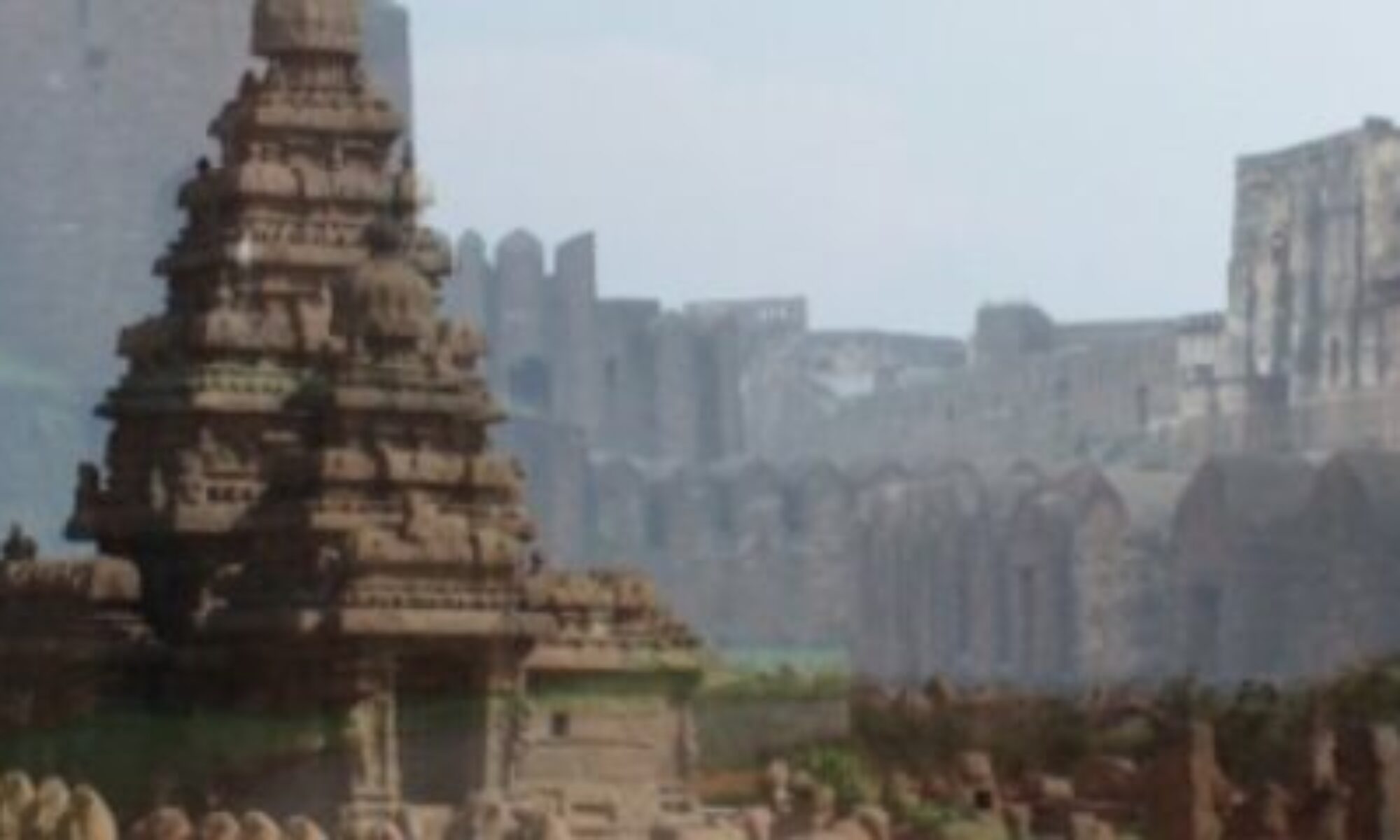Cave 1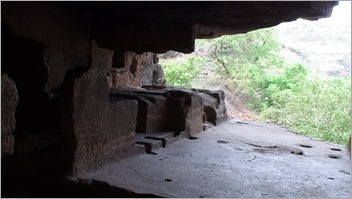 has undergone much damage and now appears almost like a huge natural opening, but the extant of the remains of some of the living-cells, mortise holes for wooden jambs and benches to serve as beds indicating that this gaping cavern represent the remains of two or more rock-cut viharas. One such vihara lay in the south-west end and had two cells in the back and three on the right side, each with a rock-cut bench.
has undergone much damage and now appears almost like a huge natural opening, but the extant of the remains of some of the living-cells, mortise holes for wooden jambs and benches to serve as beds indicating that this gaping cavern represent the remains of two or more rock-cut viharas. One such vihara lay in the south-west end and had two cells in the back and three on the right side, each with a rock-cut bench.
In the wide portion also, there are indications of cells, but it is difficult to determine their number. The rock into which the cave was excavated has, at a height of 4 feet from the floor 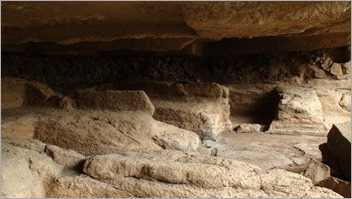 level, a very loose stratum of red bole, which in course of time weathered, thus causing the disappearance of the thin partition-walls which originally demarcated the caves from one another and otherwise contributing to the decay of the caves.
level, a very loose stratum of red bole, which in course of time weathered, thus causing the disappearance of the thin partition-walls which originally demarcated the caves from one another and otherwise contributing to the decay of the caves.
Cave 2 shares its forecourt with 3 and 4. There is a flight of eleven steps to reach the cave. The wall dividing caves 2 and 3 is completely disappeared owing to the disintegration of the rock. The extant rem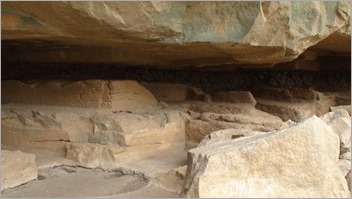 ains of Cave 2, a vihara consist a series of four cells on the right side, each provided with one or two raised benches, a long bench at the back and the damaged remains of two cells on the left. An important feature is a rock-cut drain with loose covering slabs; it drained out water which would have been otherwise flowed into Cave 3 but was very ingeniously diverted through a
ains of Cave 2, a vihara consist a series of four cells on the right side, each provided with one or two raised benches, a long bench at the back and the damaged remains of two cells on the left. An important feature is a rock-cut drain with loose covering slabs; it drained out water which would have been otherwise flowed into Cave 3 but was very ingeniously diverted through a 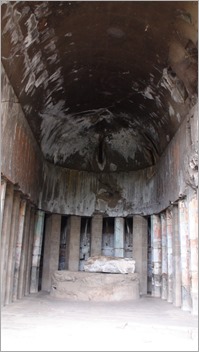 wide aperture by boring a hole into the ceiling of its vaulted roof. This effective method of dealing with leakages in rock-cut monuments is a good example of ancient conservation.
wide aperture by boring a hole into the ceiling of its vaulted roof. This effective method of dealing with leakages in rock-cut monuments is a good example of ancient conservation.
Cave 3 is a chaitya (the worship hall), measuring 35 feet wide and 86 feet long with an apsidal end. Originally there were in all thirty seven octagonal rock-cut pillars separating the aisle from the hall. Of them, the front five of the right side and four of the left are missing, except for their traces on the ground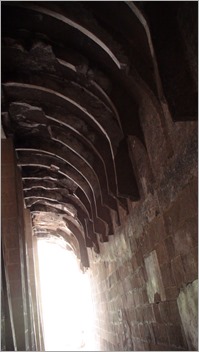 . Of the rest, sixteen were reconstructed by the former Hyderabad State as rectangular masonry pillars and the remaining twelve stand almost intact in their original form and even retain remnants of the paintings of the 6th century, as also two early inscriptions contemporaneous with the excavation of the cave. The inscriptions on the tenth and the eleventh pillars from the outside on the right, record that one was a gift by Mitadeva of the Gadhika family and the other of the sons of Samghaka, both hailing from Patithana (Prathisthana or Paithan).
. Of the rest, sixteen were reconstructed by the former Hyderabad State as rectangular masonry pillars and the remaining twelve stand almost intact in their original form and even retain remnants of the paintings of the 6th century, as also two early inscriptions contemporaneous with the excavation of the cave. The inscriptions on the tenth and the eleventh pillars from the outside on the right, record that one was a gift by Mitadeva of the Gadhika family and the other of the sons of Samghaka, both hailing from Patithana (Prathisthana or Paithan).
All the pillars have a slightly inward rake and are similar to those of the chaitya halls in Bhaja and Ajanta. The aisles are almost 5 feet wide and have stone ribs on the ceiling, which is like a half-arch. The vault of the nave was once provided with wooden ribs, as in the chaitya of Bhaja; though all woodwork has now completely perished, 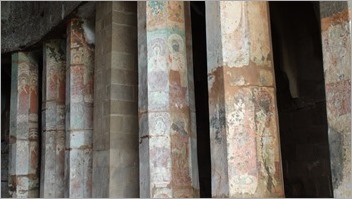 their positions can still be marked. The square spaces between the wooden ribs were once decorated with paintings on plaster, of which a few traces of panels with lotuses exist.
their positions can still be marked. The square spaces between the wooden ribs were once decorated with paintings on plaster, of which a few traces of panels with lotuses exist.
The pain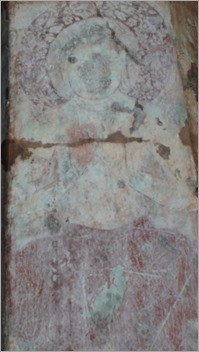 tings on the pillars and side-walls call for a special study. It may only be noted that all the pillars bear the paintings of Buddha and the Bodhisattvas. A noticeable fact about the paintings on the walls is that the original wall surface, which had badly weathered due to the disintegration of the layer of bole, was repaired with clo
tings on the pillars and side-walls call for a special study. It may only be noted that all the pillars bear the paintings of Buddha and the Bodhisattvas. A noticeable fact about the paintings on the walls is that the original wall surface, which had badly weathered due to the disintegration of the layer of bole, was repaired with clo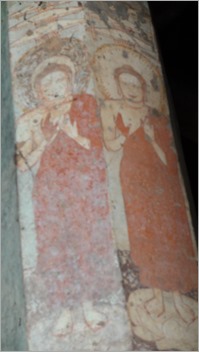 sely-jointed stone slabs and given a coat of plaster when the paintings were executed during the second phase of the caves. This is another example of ancient conservation.
sely-jointed stone slabs and given a coat of plaster when the paintings were executed during the second phase of the caves. This is another example of ancient conservation.
The stupa, owing to the friable nature of the rock, had to be partially structural and partly rock-cut; in its present state it is bereft of the anda, which was of masonry. Its circumference at the base is 36 feet. Through sheer luck, crystal r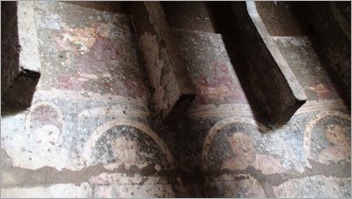 eliquaries were discovered within the stupa. They were contained on oblong sockets specially chiseled in the back side of the drum of the stupa and plugged by close filling stone slabs after the deposit of the relics inside. The rock-cut stupa in the chaitya in Bhaja, has similar sockets. It appears, therefore, that the practice of depositing reliquaries in the rock-cut stupas, in the manner described above, was in vogue when the caves were excavated.
eliquaries were discovered within the stupa. They were contained on oblong sockets specially chiseled in the back side of the drum of the stupa and plugged by close filling stone slabs after the deposit of the relics inside. The rock-cut stupa in the chaitya in Bhaja, has similar sockets. It appears, therefore, that the practice of depositing reliquaries in the rock-cut stupas, in the manner described above, was in vogue when the caves were excavated.
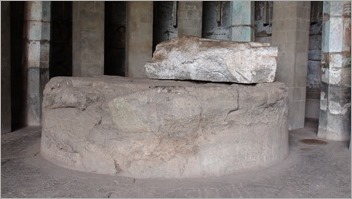 Anot
Anot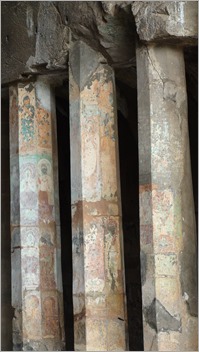 her feature that came to light is a flight of eleven steps, the lower five being on a broader basement. On the rock surface of each of the steps is a sculptural panel in low relief depicting a winged horse in the corner of the shorter side of the rhombus and two yakshas with their hands over their head, as if supporting the balustrade. On the lower basement on each side of the steps is a small round cavity 1.5 feet in diameter and 7 inches in depth, where probably loose images were fixed. The plinth almost 7 feet higher than the level of the forecourt, is otherwise plain except for the soft round moldings at the level of the upper flight of steps. On either side of the entrance was probably a low vedika, as can be seen from the remnants of cross-bars of the vedika platform and from the cavities on the door-jambs of the entrance.
her feature that came to light is a flight of eleven steps, the lower five being on a broader basement. On the rock surface of each of the steps is a sculptural panel in low relief depicting a winged horse in the corner of the shorter side of the rhombus and two yakshas with their hands over their head, as if supporting the balustrade. On the lower basement on each side of the steps is a small round cavity 1.5 feet in diameter and 7 inches in depth, where probably loose images were fixed. The plinth almost 7 feet higher than the level of the forecourt, is otherwise plain except for the soft round moldings at the level of the upper flight of steps. On either side of the entrance was probably a low vedika, as can be seen from the remnants of cross-bars of the vedika platform and from the cavities on the door-jambs of the entrance.
We will now move to to the further caves.
